Latest CoStar Composite Price Indices Rose Modestly in First Quarter 2020
CCRSI RELEASE – April 2020
(With data through March 2020)
Print Release (PDF)
Complete CCRSI data set accompanying this release
This month's CoStar Commercial Repeat Sale Indices (CCRSI) provide the market's first look at commercial real estate pricing trends through March 2020. Based on 831 repeat sale pairs in March 2020 and more than 225,707 repeat sales since 1996, the CCRSI offers the broadest measure of commercial real estate repeat sales activity.
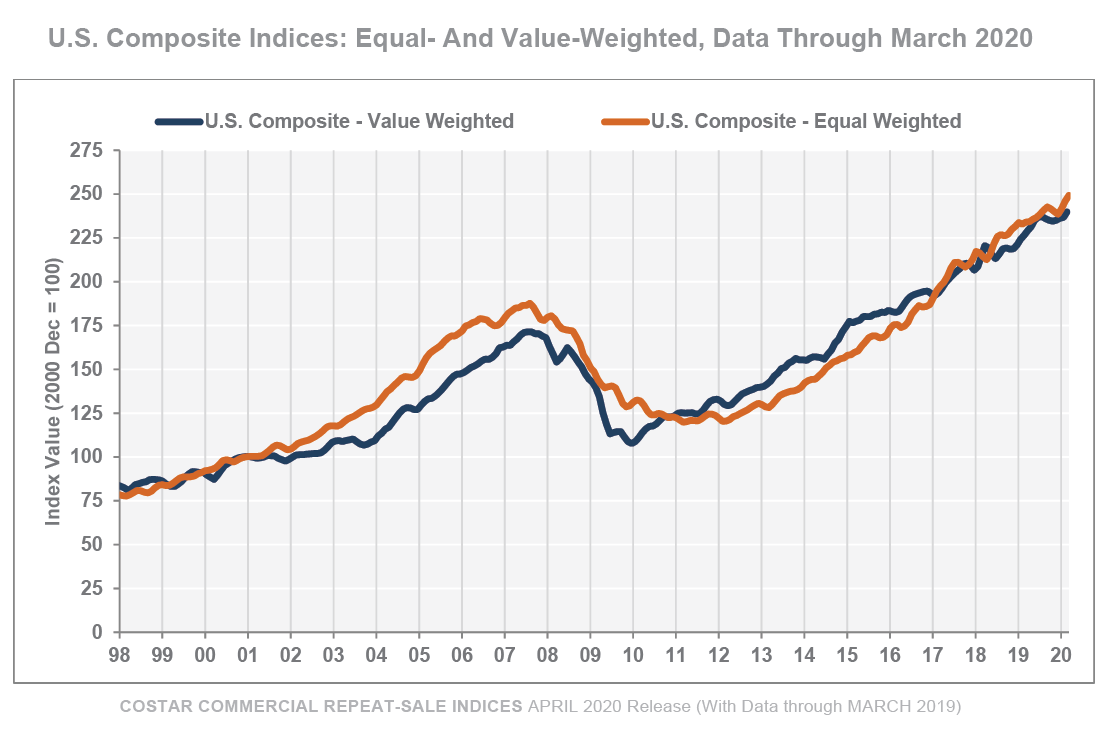
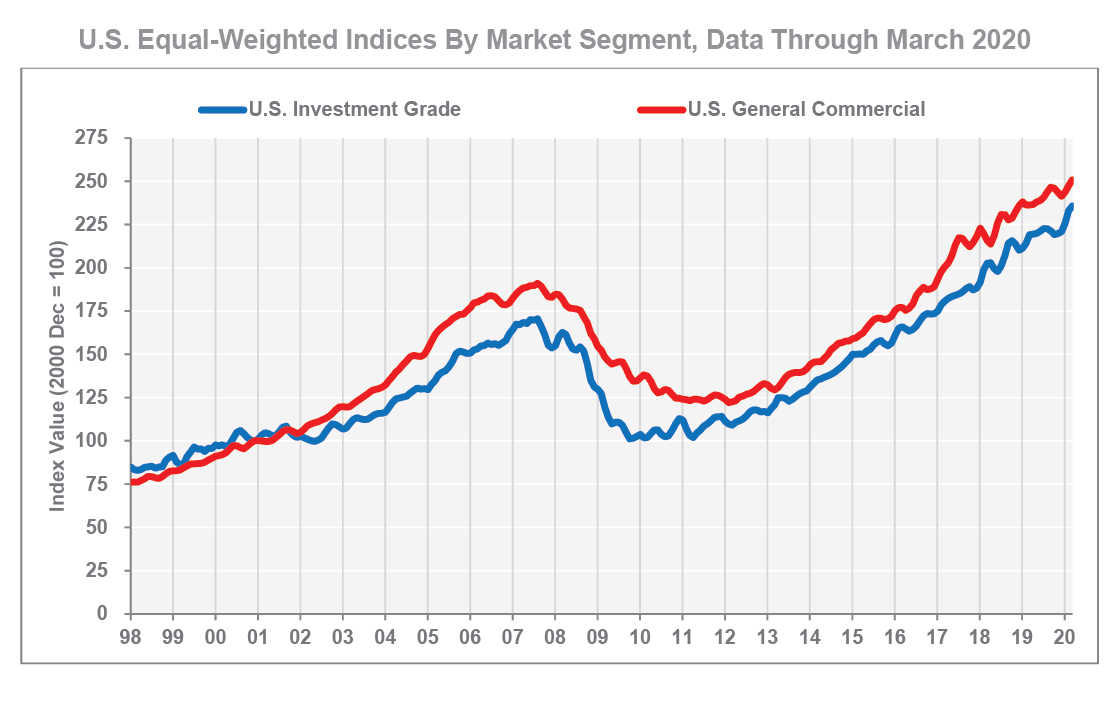
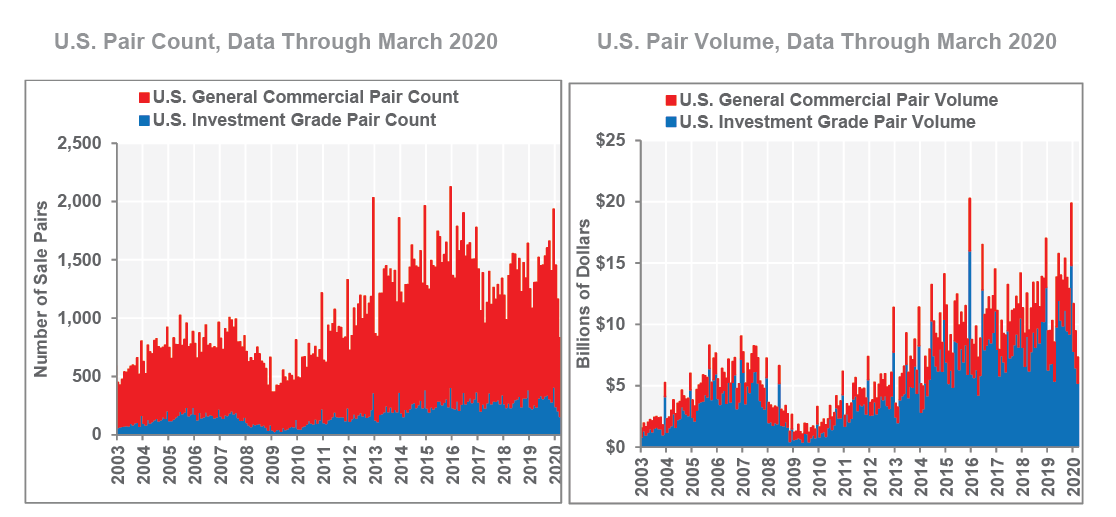


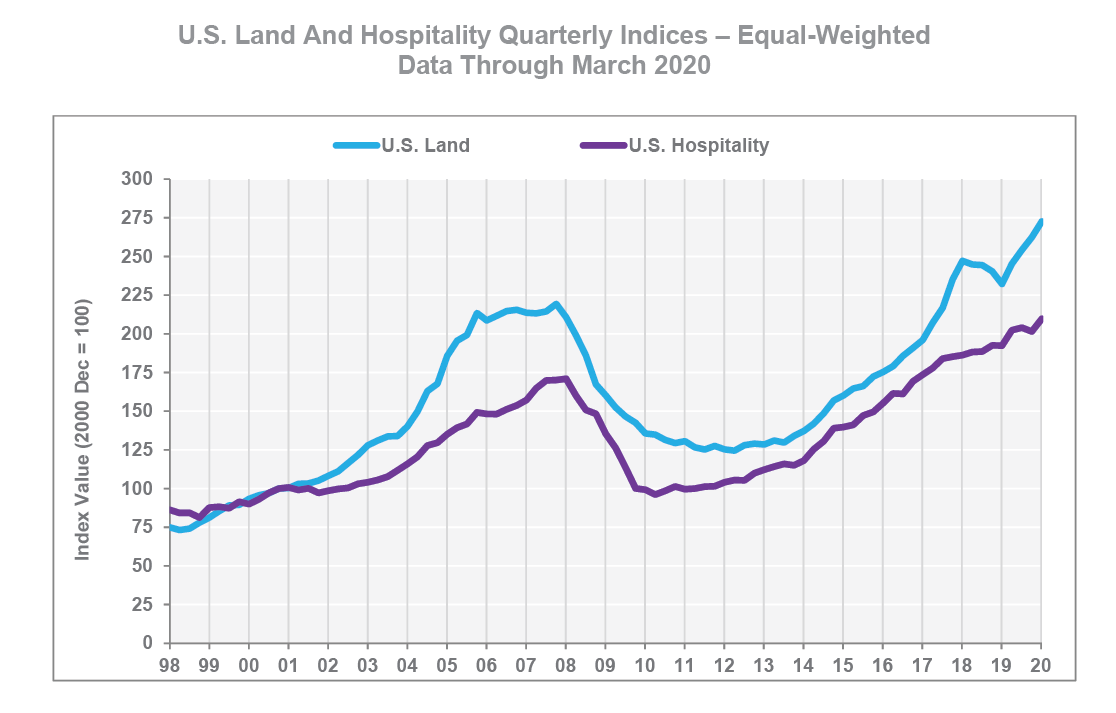
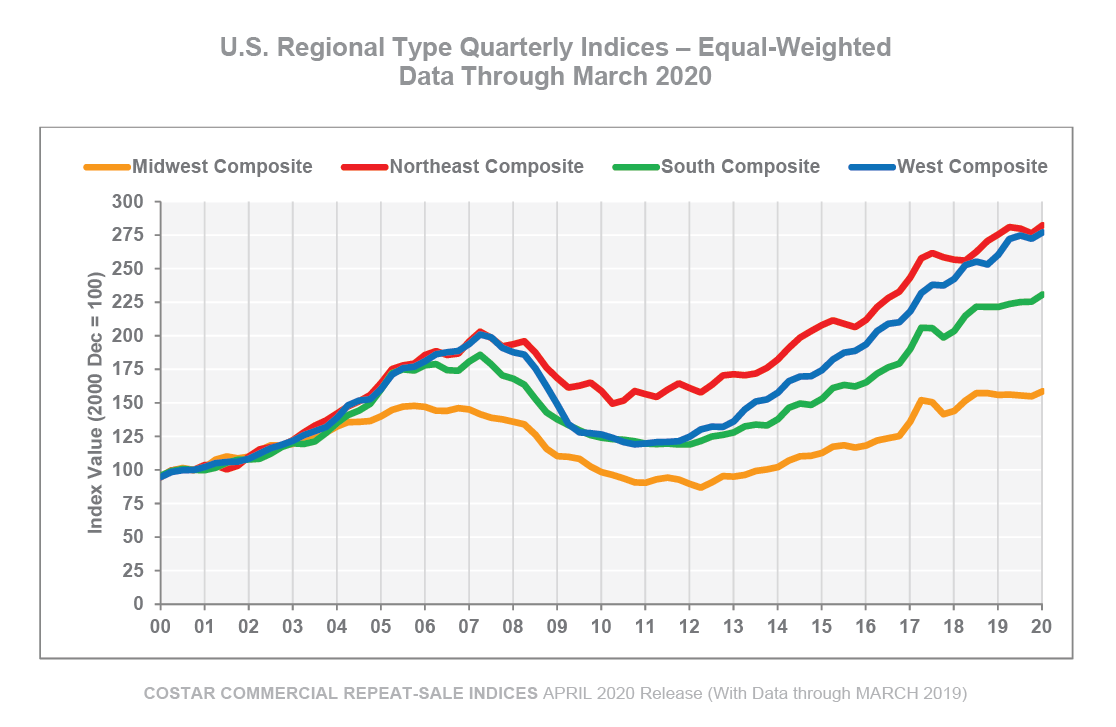
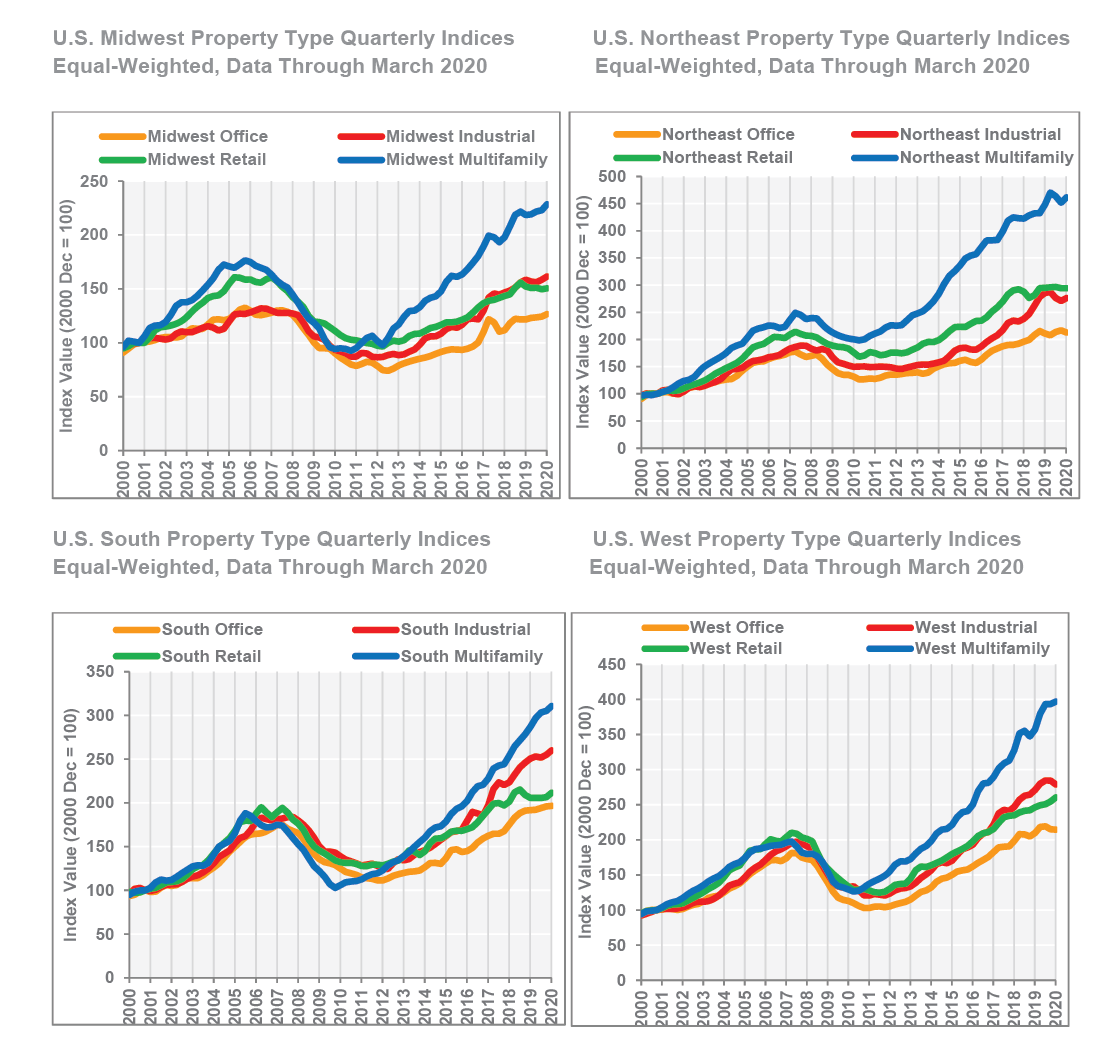
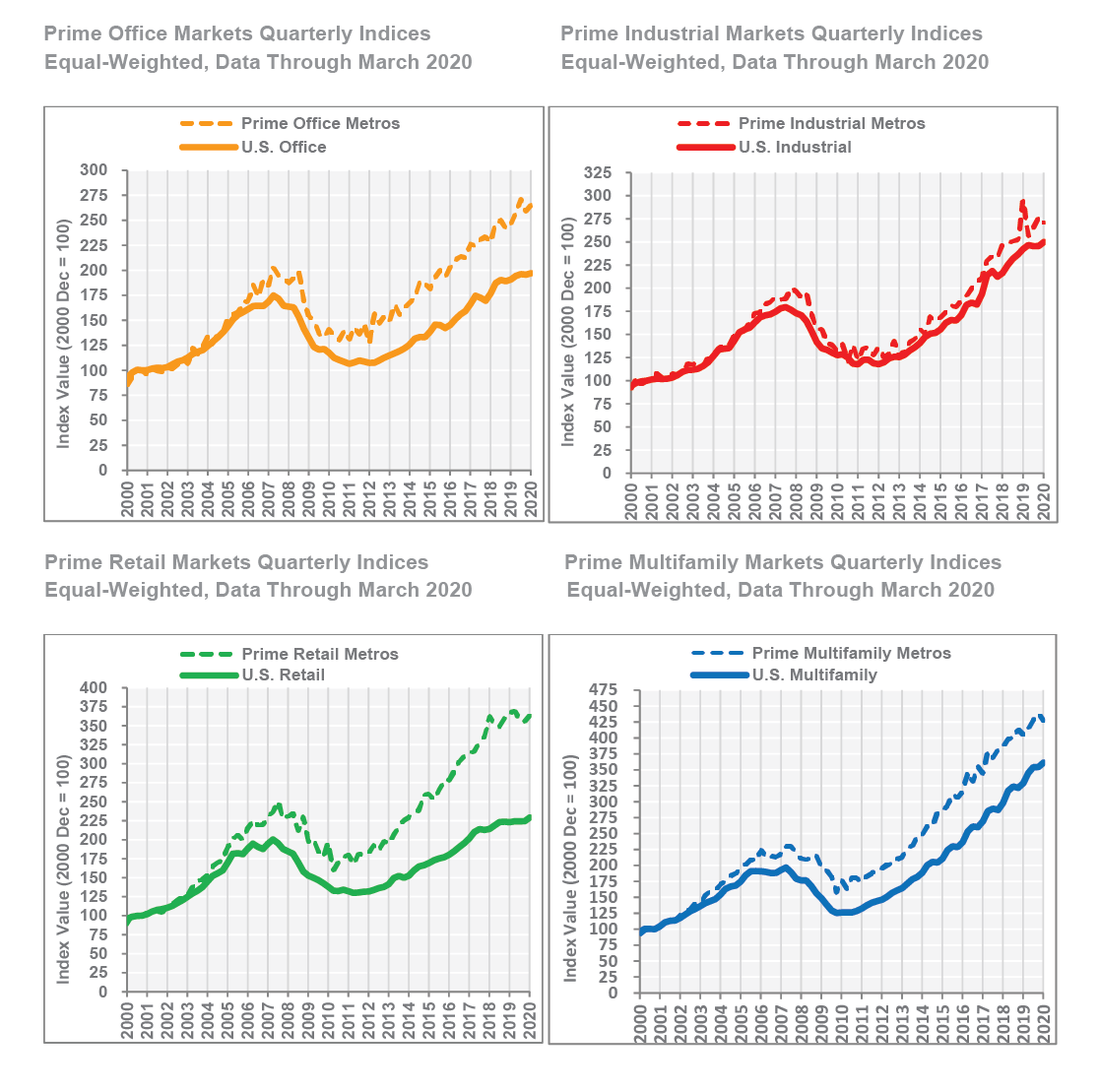
CCRSI National Results Highlights
-
COMPOSITE PRICE INDICES SHOWED SLIGHT RISE IN FIRST QUARTER OF 2020. Composite price growth in the first quarter of 2020 largely reflected the environment in the first two months of the quarter, before widespread lockdowns and social distancing measures began to have a significant impact on the economy and CRE markets. The value-weighted U.S. Composite Index, which reflects the larger asset sales common in core markets, increased 2% in the first quarter of 2020 and 5.9% in the 12-month period ending in March 2020. The equal-weighted U.S. Composite Index, which reflects the more numerous but lower-priced property sales typical of secondary and tertiary markets, advanced 4.6% in the first quarter of 2020 and 6.5% in the 12-month period ending in March 2020.
-
A SLOWDOWN IN DEAL VOLUME IS EVIDENT AS THE QUARTER PROGRESSED. Trade data lags somewhat, as deals reported in the weeks after quarter-end are still being tallied; however, the number of trades and corresponding sales volume in February and March 2020 were pacing below previous monthly averages as investors hit the pause button in the current uncertain environment. While January 2020 trading activity appears largely stable, the 1,993 repeat-sale trades in February and March 2020 recorded as of the time of writing were 17% lower than in the same two-month period in 2019. Similarly, repeat-sale transaction volume also began to drop off from recent historical average levels in February and March 2020. Composite pair volume of $16.8 billion in February and March 2020 was down 15% from the same two-month period in 2019.
-
PRICE GROWTH WAS SLOWEST IN THE RETAIL SECTOR IN THE FIRST QUARTER AS HEADWINDS FROM E-COMMERCE COMPETITION WERE ALREADY A FACTOR PRIOR TO THE PANDEMIC. The U.S. Retail index rose 2.7% in the 12-month period ending in March 2020, the slowest annual growth rate among the major property type indices. Despite headwinds from e-commerce facing the sector, retail pricing has been strongest in well-located centers focused on necessity-based goods, while centers that compete more directly with e-commerce have lagged. The U.S. Multifamily Index advanced 9.8% in the 12-month period ending in March 2020, which was the strongest annual growth rate of the four property type indices in the CCRSI.
-
THE WEST LED GROWTH AMONG THE FOUR REGIONAL INDICES THROUGH THE FIRST QUARTER OF 2020. Outsized gains in the multifamily segment fueled annual growth of 6.4% in the West Composite Index in the 12-month period ending in March 2020. The Midwest Composite Index, with its concentration of mature, slower growing markets, was the laggard with 1.7% growth in the 12-month period ending in March 2020.

Quarterly CCRSI Property Type Results
-
PROPERTY SECTORS POSTED MODEST GAINS IN THE FIRST QUARTER PRIOR TO COVID-19 IMPACT. The eventual impact of the pandemic and economic fallout on commercial real estate market fundamentals and pricing is currently unclear. While lockdowns and social distancing measures became the norm late into the first quarter 2020, the full impact of the pandemic on property pricing has yet to unfold. The major property type indices posted average price growth of 1.7% in the first quarter, and 4.7% in the 12-month period ending in March 2020. The Prime Markets Indices within each property sector, which are dominated by the large, core, coastal metros, generally increased at a slower pace than the national property type indices during the 12-month period ending in March 2020, confirming that commercial property price gains were broad-based. The exception to this was the office sector, for which the prime metros index advanced at a stronger than average rate in the last 12 months ending in March 2020.
-
THE MULTIFAMILY INDEX LED GROWTH AMONG THE FOUR MAJOR PROPERTY TYPES. The U.S. Multifamily Index expanded 2% in the first quarter 2020, contributing to an annual gain of 9.8% in the 12-month period ending in March 2020, maintaining its position as one of the strongest property type indices over the last cycle. Capital continued to move down the risk spectrum, as secondary markets experienced stronger pricing gains. The Prime Multifamily Metros Index increased at a slower rate of 5.3% in the 12-month period ending in March 2020.
-
SOLID GAINS PERSISTED IN THE INDUSTRIAL INDEX. Prior to the COVID-19 outbreak, industrial fundamentals remained on solid footing, with vacancies hovering just above 5%, driving sustained above-trend rent growth in the first quarter 2020. Pricing increased, with the U.S. Industrial index up 1.8% in the first quarter and 3.1% in the 12-month period ending in March 2020. Pricing in the broader industrial index outpaced that of the Prime Industrial Metros Index in the most recent quarterly and annual period ending March 2020.
-
OFFICE PRICES CONTINUED PACE OF MODEST GROWTH. The U.S. Office Index increased 0.8% in the first quarter of 2020, which was on par with the average quarterly gain over the previous four quarters. Over the last year, office prices were up 3.4% in the 12-month period ending in March 2020. Price growth in the Prime Office Metros Index advanced 7.9% in the 12-month period ending in March 2020, reflecting continued investor demand in the larger core coastal markets.
-
RETAIL PRICING IN THE LAST YEAR WAS WEAKEST AMONG THE FOUR MAJOR PROPERTY TYPES. The U.S. Retail index rose 2.2% in the first quarter of 2020 but amounted to an annual gain of just 2.7% in the 12-month period ending in March 2020. The bifurcation in retail fundamentals performance translates to the investment market as well. Good quality, well-located retail continued to command investor interest and pricing growth, while pricing regressed in centers with elevated vacancy rates and poor locational characteristics. The Prime Retail Metros Index declined 0.9% in the 12-month period ending in March 2020.
-
WHILE HOSPITALITY SECTOR FUNDAMENTALS HAVE SUFFERED SIGNIFICANTLY IN THE WAKE OF THE COVID-19 PANDEMIC, PRICING IN THE FIRST QUARTER HAD YET TO REFLECT THESE CONDITIONS. The U.S. Hospitality Index was up 4.1% in the first quarter 2020, contributing to annual gains of 9% in the 12-month period ending in March 2020.
-
U.S. LAND INDEX MOST VOLATILE OF THE PROPERTY TYPE INDICES. The U.S. Land Index is currently the most volatile of the property type indices. After falling throughout most of 2018 and early 2019, the index rebounded over the last several quarters, and ended the 12-month period ending in March 2020 up 17.4% on the strength of continued demand for development sites.
Quarterly CCRSI Regional Results
-
PRICE GROWTH ACROSS THE SPECTRUM OF PROPERTY TYPES BOLSTERED WEST REGIONAL INDEX. The West Composite Index advanced 6.1% in the 12-month period ending in March 2020, besting annual growth in the other regions. The West Multifamily Index was up 11.1% over the prior 12-month period ending March 2019 and was the only regional property type index to reach double-digit growth in the 12-month period ending in March 2020.
-
A HIGH CONCENTRATION OF FASTER GROWING SUNBELT MARKETS DROVE SOLID GROWTH IN THE SOUTH REGION. The South Index rose 4.2% in the 12-month period ending in March 2020, led by above average performance in the South Multifamily and South Industrial indices. The South Retail and Office indices grew more slowly, which follows the national trend. A higher concentration of faster growing, low cost metros in the South region has bolstered both demand for commercial real estate and pricing in the South region.
-
NORTHEAST REGIONAL GROWTH DECELERATED IN LAST 12 MONTHS. The Northeast Composite Index advanced 2.5% in the 12-month period ending in March 2020, which was down from the 7.4% annual pace of growth in the 12-month period ending in March 2019. As has been the case in the other regions, the Northeast Multifamily Index posted the strongest growth in the region over the last 12 months ending in March 2020, increasing 2.9%, while the Northeast Retail and Industrial indices posted modest losses of 0.2% and 3.3%, respectively, in the 12-month period ending in March 2020.
-
WEAKNESS IN THE RETAIL SEGMENT HELD DOWN STRONGER GROWTH IN THE MIDWEST REGIONAL INDEX. The Midwest Composite index edged up 1.7% in the 12-month period ending in March 2020. Recent declines of 1.1% in the Midwest Retail Index were a drag on recent growth, while the Midwest Multifamily Index was the stand-out performer, advancing 4.5% in the 12-month period ending in March 2020.
About The CoStar Commercial Repeat-Sale Indices
The CoStar Commercial Repeat-Sale Indices (CCRSI) is the most comprehensive and accurate measure of commercial real estate prices in the United States. In addition to the national Composite Index (presented in both equal-weighted and value-weighted versions), national Investment-Grade Index, and national General Commercial Index, which we report monthly, we report quarterly on 30 sub-indices in the CoStar index family. The sub-indices include breakdowns by property sector (office, industrial, retail, multifamily, hospitality, and land), by region of the country (Northeast, South, Midwest, and West), by transaction size and quality (general commercial, investment-grade), and by market size (composite index of the prime market areas in the country).
The CoStar indices are constructed using a repeat sales methodology, widely considered the most accurate measure of price changes for real estate. This methodology measures the movement in the prices of commercial properties by collecting data on actual transaction prices. When a property is sold more than once, a sales pair is created. The prices from the first and second sales are then used to calculate price movement for the property. The aggregated price changes from all of the sales pairs are used to create a price index.
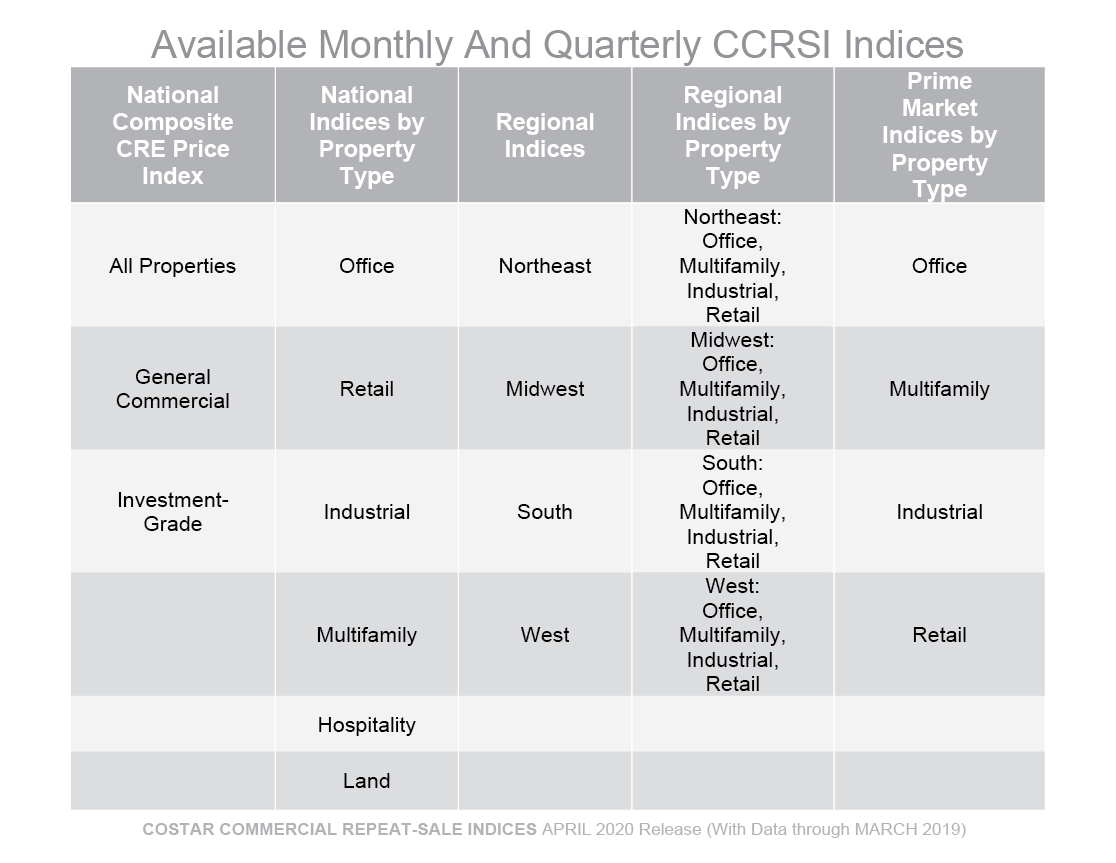

Media Contact:
Gay Beach,
Sr. Director of Marketing Communications,
CoStar Group
(gbeach@costargroup.com).
For more information about the CCRSI Indices, including the full accompanying data set and research methodology, legal notices and disclaimer, please visit https://costargroup.com/costar-news/ccrsi.
ABOUT COSTAR GROUP, INC.
CoStar Group, Inc. (NASDAQ: CSGP) is the leading provider of commercial real estate information, analytics and online marketplaces. Founded in 1987, CoStar conducts expansive, ongoing research to produce and maintain the largest and most comprehensive database of commercial real estate information. Our suite of online services enables clients to analyze, interpret and gain unmatched insight on commercial property values, market conditions and current availabilities. STR provides premium data benchmarking, analytics and marketplace insights for the global hospitality sector. LoopNet is the most heavily trafficked commercial real estate marketplace online with over 6 million monthly unique visitors. Realla is the UK’s most comprehensive commercial property digital marketplace. Apartments.com, ApartmentFinder.com, ForRent.com, ApartmentHomeLiving.com, Westside Rentals, AFTER55.com, CorporateHousing.com, ForRentUniversity.com and Apartamentos.com form the premier online apartment resource for renters seeking great apartment homes and provide property managers and owners a proven platform for marketing their properties. CoStar Group’s websites attracted an average of approximately 55 million unique monthly visitors in aggregate in the first quarter of 2020. Headquartered in Washington, DC, CoStar maintains offices throughout the U.S. and in Europe, Canada and Asia with a staff of over 4,200 worldwide, including the industry’s largest professional research organization. For more information, visit www.costargroup.com.

